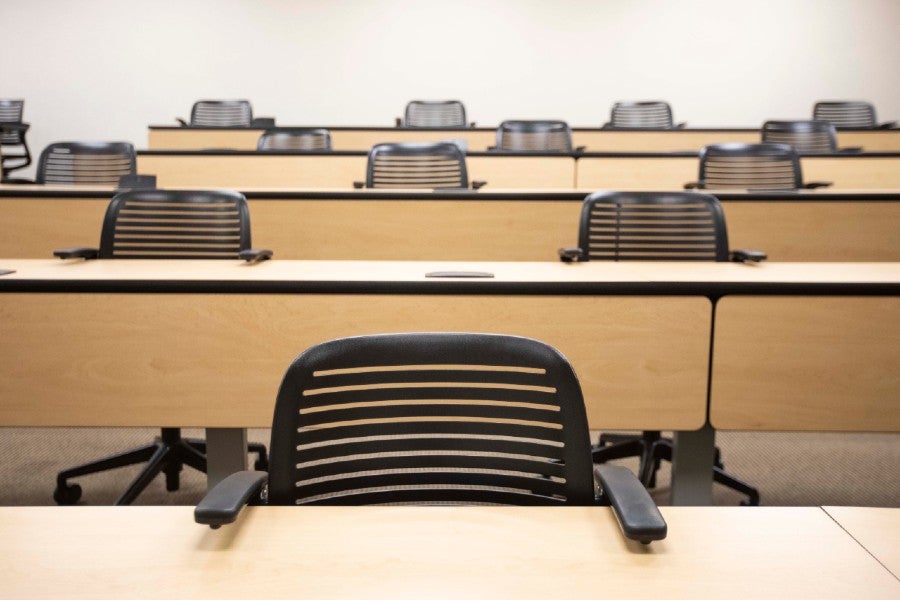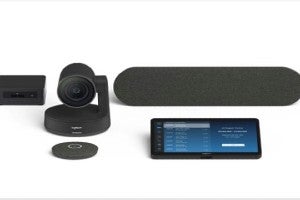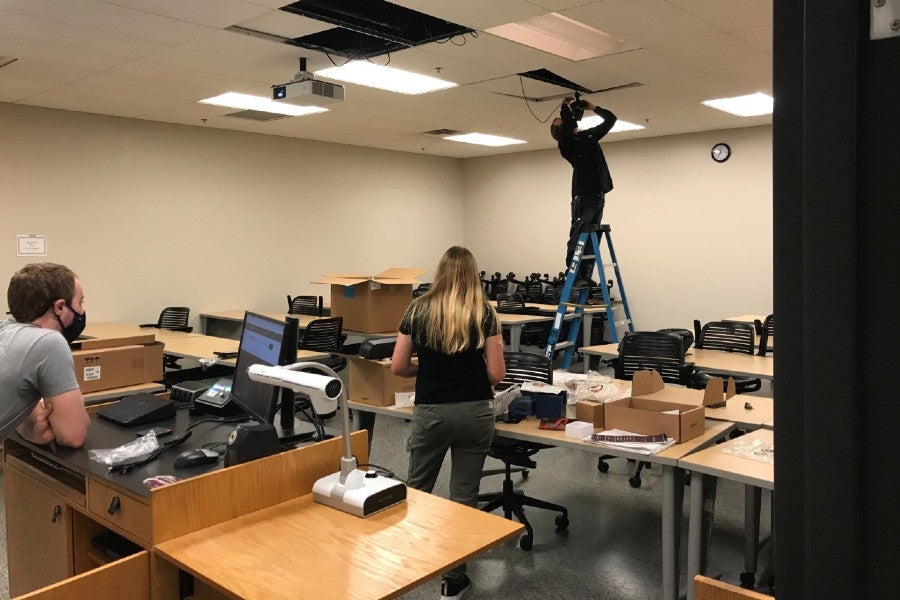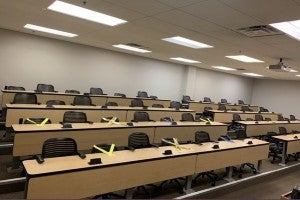Fall semester 2020 brings new learning opportunities to students
LipscombFLEX provides active engagement for both on-campus and online students.
Janel Shoun-Smith | 615.966.7078 |

Following national and local public health guidelines, Lipscomb officials have physically distanced chairs in all classrooms for the coming fall.
The official start of fall 2020 classes at Lipscomb on Aug. 24 will also bring a new form of instruction that promises to engage students no matter where they are physically located: in class or off-campus.
LipscombFLEX will use video-conferencing, new cameras, microphones and asynchronous/synchronous online platforms to allow faculty to teach both students in the classroom and remote students. Instruction can be either all at the same class time or in asynchronous methods such as online written discussion groups or collaborative web platforms.
By working ahead of time to design their course curriculum to work both in-person and online simultaneously, faculty will have the flexibility to switch formats at any time for any particular student or for all students if needed.

$300,000 in new Zoom technology was purchased to outfit classrooms for fall.
Throughout the summer, academic leaders have been preparing and investing $300,000 to launch LipscombFLEX, what is called a modified Hyflex (short for “hybrid” and “flexible”) delivery model in education settings, said Andy Borchers, associate dean in the College of Business and coordinator of the LipscombFLEX transition.
First, all classrooms were measured to determine how many students could attend in that space, per the recommended guidelines of the Centers for Disease Control. The team found that 60% of classrooms have enough room to hold the classes scheduled for that space within social distancing guidelines, Borchers said.
In addition, several large spaces not usually used for classroom instruction—such as Collins Alumni Auditorium and the SunTrust Center for Collaborative Learning in the Ezell Center—will be used for classrooms in the fall.
For the 40% of the remaining classroom spaces, faculty teaching in those classrooms will use newly purchased technology to divide their students into cohorts, with cohorts taking turns meeting in the classroom or attending through video-conferencing. Given the room size and enrollment numbers, some of those classes using cohorts may need to have only two or three students rotating through a remote cohort each week, Borchers said.
“We’re finding some innovative ways to do the cohorting,” said Borchers. “Faculty innovation and creativity are being used to find ways to achieve the goals we have to provide equivalent opportunities in different ways while maintaining COVID safety concerns.”
Some hands-on, upper-level science labs do require in-person attendance, Borchers said. Those labs, when needed, may divide activities into parts to allow cohorts to do some activities in the lab in one session and some activities at their residence during another session, he said.
Because students with an increased vulnerability to contracting COVID-19 have the option to register for classes as fully remote students throughout the fall and other students could potentially require self-isolation during the semester, faculty in every course must be prepared to engage both in-person and remote students at the same time, Borchers said.

This summer employees have been working to install the technology needed in classrooms to allow students both in-person and off-site to engage and participate.
In order to allow student to actively participate in class discussions and projects, technology such as microphones, portable webcams, screen-sharing technology and cameras that can zoom in on specific sections of the classroom had to be purchased. Helpful technology such as interactive whiteboards and easily movable furniture were already in place.
Such technology allows online students to speak up during class. Breakout room technology within Zoom, a video conferencing platform, allows online cohorts to work together within small groups. Computer simulations allows science students to see demonstrated experiments, Borchers said.
Some courses may also utilize a facilitator in the class to monitor and ensure online student participation. Student and faculty can also record videos of lectures or student presentations to view outside of the regular class meeting time.
Unlike the spring semester, when a shutdown forced faculty to transfer curriculum designed for in-person delivery into a remote format, LipscombFLEX this fall asks faculty to design the online or remote aspects of their course on the front end and then incorporate engagement and interaction with the on-the-ground format, said Hope Nordstrom, director of the Center for Teaching and Learning, which works to ensure the university’s teaching excellence.

Over the summer, a team determined that 60 percent of classrooms are large enough to hold their classes, even with the chairs physically distanced.
“It’s important for faculty to begin the process of course development with an intentional focus on equitable interaction opportunities between both in-person and online cohorts,” Nordstrom said. “It really is the new normal in terms of higher education. Consistency and communication will be key to effectively reach all students.”
Now, with less than a month before students will begin taking classes, faculty are in training to learn the new technology, how to manage their classroom activities to engage both in-person and online students and how to design their curriculum for both formats, as well as the details of public health guidelines and procedures.
“We are committed to providing the students at home the same experience as those in class,” Borchers said.